支付结算系统术语与解释
- 格式:doc
- 大小:109.50 KB
- 文档页数:23
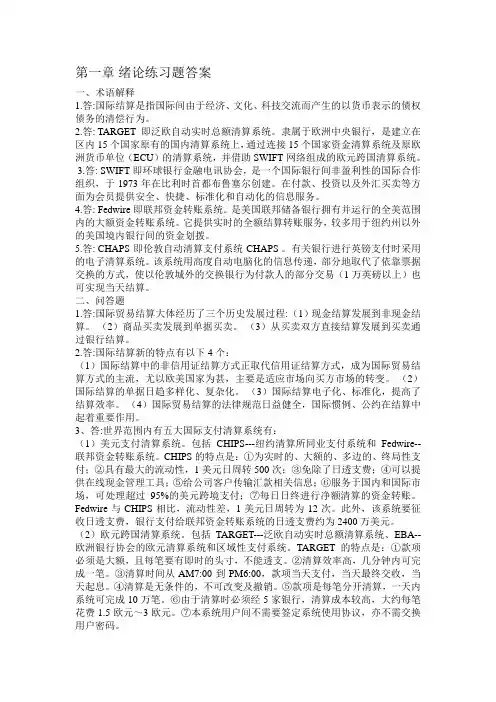
第一章绪论练习题答案一、术语解释1.答:国际结算是指国际间由于经济、文化、科技交流而产生的以货币表示的债权债务的清偿行为。
2.答: TARGET即泛欧自动实时总额清算系统。
隶属于欧洲中央银行,是建立在区内15个国家原有的国内清算系统上,通过连接15个国家资金清算系统及原欧洲货币单位(ECU)的清算系统,并借助SWIFT网络组成的欧元跨国清算系统。
3.答: SWIFT即环球银行金融电讯协会,是一个国际银行间非盈利性的国际合作组织,于1973年在比利时首都布鲁塞尔创建。
在付款、投资以及外汇买卖等方面为会员提供安全、快捷、标准化和自动化的信息服务。
4.答: Fedwire即联邦资金转账系统。
是美国联邦储备银行拥有并运行的全美范围内的大额资金转账系统。
它提供实时的全额结算转账服务,较多用于纽约州以外的美国境内银行间的资金划拨。
5.答: CHAPS即伦敦自动清算支付系统CHAPS 。
有关银行进行英镑支付时采用的电子清算系统。
该系统用高度自动电脑化的信息传递,部分地取代了依靠票据交换的方式,使以伦敦城外的交换银行为付款人的部分交易(1万英磅以上)也可实现当天结算。
二、问答题1.答:国际贸易结算大体经历了三个历史发展过程: (1)现金结算发展到非现金结算。
(2)商品买卖发展到单据买卖。
(3)从买卖双方直接结算发展到买卖通过银行结算。
2.答:国际结算新的特点有以下4个:(1)国际结算中的非信用证结算方式正取代信用证结算方式,成为国际贸易结算方式的主流,尤以欧美国家为甚,主要是适应市场向买方市场的转变。
(2)国际结算的单据日趋多样化、复杂化。
(3)国际结算电子化、标准化,提高了结算效率。
(4)国际贸易结算的法律规范日益健全,国际惯例、公约在结算中起着重要作用。
3、答:世界范围内有五大国际支付清算系统有:(1)美元支付清算系统。
包括CHIPS---纽约清算所同业支付系统和Fedwire--联邦资金转账系统。
CHIPS的特点是:①为实时的、大额的、多边的、终局性支付;②具有最大的流动性,1美元日周转500次;③免除了日透支费;④可以提供在线现金管理工具;⑤给公司客户传输汇款相关信息;⑥服务于国内和国际市场,可处理超过95%的美元跨境支付;⑦每日日终进行净额清算的资金转账。
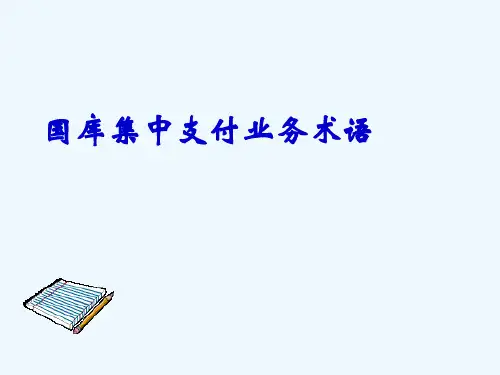
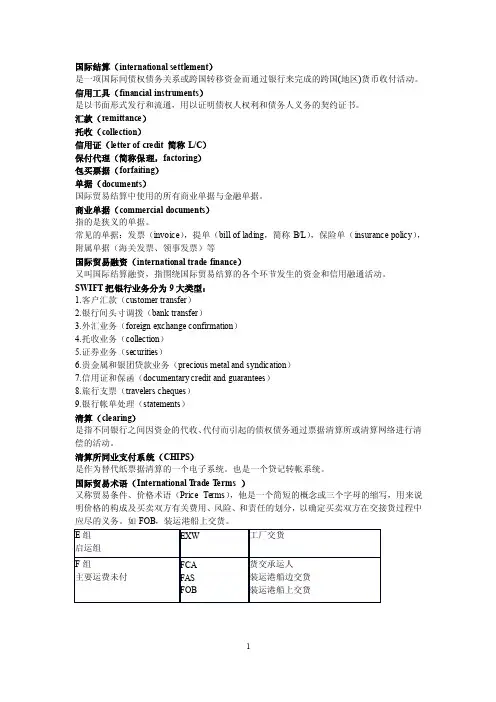
国际结算(international settlement)是一项国际间债权债务关系或跨国转移资金而通过银行来完成的跨国(地区)货币收付活动。
信用工具(financial instruments)是以书面形式发行和流通,用以证明债权人权利和债务人义务的契约证书。
汇款(remittance)托收(collection)信用证(letter of credit 简称L/C)保付代理(简称保理,factoring)包买票据(forfaiting)单据(documents)国际贸易结算中使用的所有商业单据与金融单据。
商业单据(commercial documents)指的是狭义的单据。
常见的单据:发票(invoice),提单(bill of lading,简称B/L),保险单(insurance policy),附属单据(海关发票、领事发票)等国际贸易融资(international trade finance)又叫国际结算融资,指围绕国际贸易结算的各个环节发生的资金和信用融通活动。
SWIFT把银行业务分为9大类型:1.客户汇款(customer transfer)2.银行间头寸调拨(bank transfer)3.外汇业务(foreign exchange confirmation)4.托收业务(collection)5.证券业务(securities)6.贵金属和银团贷款业务(precious metal and syndication)7.信用证和保函(documentary credit and guarantees)8.旅行支票(travelers cheques)9.银行帐单处理(statements)清算(clearing)是指不同银行之间因资金的代收、代付而引起的债权债务通过票据清算所或清算网络进行清偿的活动。
清算所同业支付系统(CHIPS)是作为替代纸票据清算的一个电子系统。
也是一个贷记转帐系统。
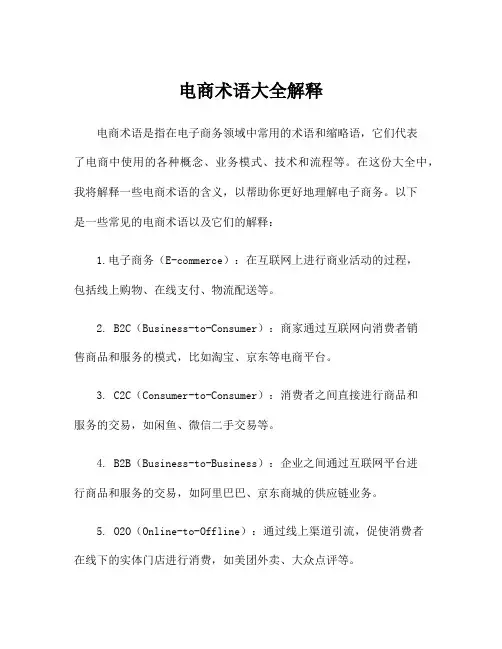
电商术语大全解释电商术语是指在电子商务领域中常用的术语和缩略语,它们代表了电商中使用的各种概念、业务模式、技术和流程等。
在这份大全中,我将解释一些电商术语的含义,以帮助你更好地理解电子商务。
以下是一些常见的电商术语以及它们的解释:1.电子商务(E-commerce):在互联网上进行商业活动的过程,包括线上购物、在线支付、物流配送等。
2. B2C(Business-to-Consumer):商家通过互联网向消费者销售商品和服务的模式,比如淘宝、京东等电商平台。
3. C2C(Consumer-to-Consumer):消费者之间直接进行商品和服务的交易,如闲鱼、微信二手交易等。
4. B2B(Business-to-Business):企业之间通过互联网平台进行商品和服务的交易,如阿里巴巴、京东商城的供应链业务。
5. O2O(Online-to-Offline):通过线上渠道引流,促使消费者在线下的实体门店进行消费,如美团外卖、大众点评等。
6. CRM(Customer Relationship Management):客户关系管理,是一种通过技术手段管理和建立企业与客户之间关系的策略和方法。
7. CPA(Cost Per Action):行动成本,是一种广告费用计算方式,广告主只需支付广告渠道上实际发生某种行为的费用,如点击、注册等。
8. CPM(Cost Per Mille):千次展示成本,是一种广告费用计算方式,按广告千次展示的费用进行计算,常用于媒体广告投放。
9. CPC(Cost Per Click):每次点击费用,是一种广告费用计算方式,广告主按实际点击次数支付费用,常用于搜索引擎广告。
10. CPS(Cost Per Sale):每次销售费用,是一种广告费用计算方式,广告主按销售数量支付费用,常用于电商平台的联盟营销。
11. SKU(Stock Keeping Unit):库存保管单位,是一种商品库存管理的编号方式,用于追踪商品的唯一标识。
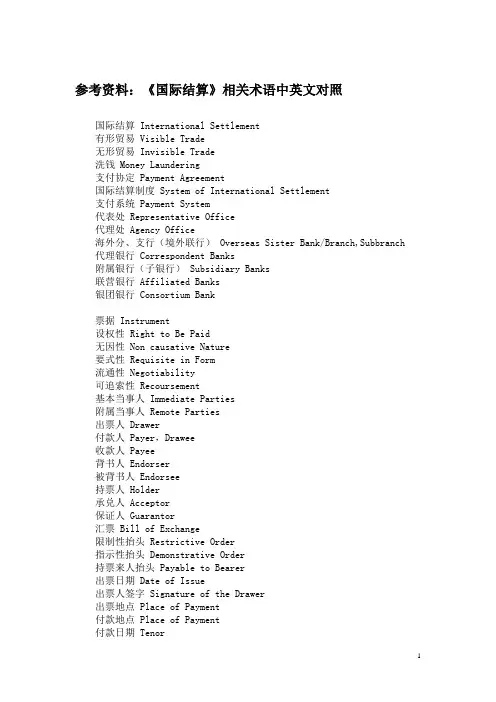
参考资料:《国际结算》相关术语中英文对照国际结算 International Settlement有形贸易 Visible Trade无形贸易 Invisible Trade洗钱 Money Laundering支付协定 Payment Agreement国际结算制度 System of International Settlement支付系统 Payment System代表处 Representative Office代理处 Agency Office海外分、支行(境外联行) Overseas Sister Bank/Branch,Subbranch 代理银行 Correspondent Banks附属银行(子银行) Subsidiary Banks联营银行 Affiliated Banks银团银行 Consortium Bank票据 Instrument设权性 Right to Be Paid无因性 Non causative Nature要式性 Requisite in Form流通性 Negotiability可追索性 Recoursement基本当事人 Immediate Parties附属当事人 Remote Parties出票人 Drawer付款人 Payer,Drawee收款人 Payee背书人 Endorser被背书人 Endorsee持票人 Holder承兑人 Acceptor保证人 Guarantor汇票 Bill of Exchange限制性抬头 Restrictive Order指示性抬头 Demonstrative Order持票来人抬头 Payable to Bearer出票日期 Date of Issue出票人签字 Signature of the Drawer出票地点 Place of Payment付款地点 Place of Payment付款日期 Tenor见票即付 At Sight or on Demand定日付款 At a Fixed Date见票后定期付款 At a Fixed Period after Sight出票后定期付款 At a Fixed Period after Date付一不付二 Pay This First/Second Bill担当付款人 Person Designated as payer预备付款人 Referee in Case of Need必须提示承兑 Presentment for Acceptance Required 不得提示承兑 Acceptance Prohibited付对价持票人 Holder for Value正当持票人Holder in Due Course/Bona Fide Holder 银行汇票 Banker’s Draft商业汇票 Trade Bill承兑汇票Acceptance Bill银行承兑汇票 Banker’s Acceptance Bill商业承兑汇票 Trade’s Acceptance Bill即期汇票 Sight Draft ,Demand Draft远期汇票 Time Bill, Usance Bill光票 Clean Bill跟单汇票 Documentary Bill本票 Promissory Note商业本票Promissory Note银行本票 Cashier’s Order/Check国际汇票 Overseas Money Order支票 Cheque or Check出票 Issue背书 Indorsement承兑 Acceptance保证 Guarantee保付 Certified to Pay提示 Presentation付款 Payment拒付 Dishonour追索 Recourse顺汇 Remittance逆汇 Reverse Remittance汇款人 Remitter汇出行 Remitting Bank汇入行 Paying Bank收款人 Payee电汇 Telegraphic Transfer信汇 Mail Transfer票汇 Remittance by Banker’s Demand Draft预付货款 Payment in Advance货到付款 Payment after Arrival of the Goods托收 Collection委托人 Principal托收行 Remitting Bank代收行 Collecting Bank付款人 Drawee提示行 Presenting Bank托收申请书 Collection Application托收委托书 Collection Advice信用证 Letter of Credit议付行 Negotiating Bank偿付行 Reimbursing Bank开证申请人Applicant开证行 Issuing Bank受益人 Beneficiary通知行 Advising Bank保兑行 Confirming Bank付款行 Paying Bank光票信用证 Clean Credit跟单信用证 Document Credit不可撤销信用证Irrevocable Credit可撤销信用证 Revocable Credit保兑信用证 Confirmed Credit不保兑信用证 Unconfirmed Credit即期付款信用证 Sight Payment Credit延期付款信用证 Deferred Payment Credit承兑信用证 Acceptance Credit转让信用证 Transferable Credit不可转让信用证 Nor-transferable Credit背对背信用证 Back to Back Credit循环信用证 Revolving Credit预支信用证 Anticipatory Credit银行保函 Letter of Guarantee申请人 Applicant/Principal受益人 Beneficiary担保行 Guarantor Bank通知行 Advising Bank转开行 Reissuing Bank反担保行 Counter Guarantor Bank保兑行 Confirming Bank投标保函 Tender Gurantee履约保函 Performance Gurantee预付款保函 Advanced Payment Gurantee质量保函Quality Gurantee关税保付保函 Customs Gurantee付款保函 Payment Gurantee延期付款保行 Defeerd Payment Gurantee补偿贸易保函 Compensation Gurantee来料加工保函 Processing Gurantee租赁保函 Lease Gurantee借款保函 Loan Gurantee保释金保函 Bail Bond票据保付保函Gurantee For Bill费用保付保函 Payment Gurantee for Commission 备用信用证 Stand-by Letter of Credit单据 Documents商业发票 Commercail Invoice首文 Heading正文Body海关发票 Customs Invoice形式发票 Proforma Invoice领事发票 Consular Invoice样品发票 Sample Invoice广商发票 Manufacturer Invoice证实发票 Certified Invoice货物运输单据 Transport documents海运提单Marine Bill of Loading托运人 Shipper/Consignor承运人 Carrier收货人 Consignee受让人 Transferee or Assignee已装船提单 Shipped on Board待运提单 Received for Shipment直达提单Direct B/L转船提单 Transshipmen B/L联运提单 Through B/L清洁提单 Clean B/L不清洁提单 Unclean B/L记名提单 Straight B/L不记名提单 Open B/L指示性提单 Order B/L简式提单 Short Form B/L全式提单 Long Form B/L班轮提单 Liner B/L租船提单 Charter B/L运输代理行提单 Horse B/L过期提单 Stale B/L倒签提单Anti-dated B/L集装箱运输提单 Container B/L多式运输 Multimodal Transport多是运输单据Multimodal Transport Document不可流通转让的海运单 Non-negotiable Sea Waybill租船合约提单 Charter Party Bill of Lading航空运单 Airway Bill基本险 Chief Risk一般附加险 Additional Risk特殊附加险 Special Additional Risk保险单 Insurance Policy预约保险单Open Policy of Open Cover保险凭证 Insurance Certificate保险声明 Insurance Declaration联合凭证 Combined Certificate暂保单 Cover Note商品验证说明 Inspection Certificate产地证明书 Certificate of Origin包装单据 Packing Document装货箱 Packing List重量单 Weight List打包贷款 Packing Credit/Loan出口押汇 Outward Bill质押书 Letter of Hypothecation出口托收押汇 Advance against Documentary Collection 银行承兑 Bank’s Acceptance票据贴现 Bill Discount出口发票 Invoice Discounting进口开证额度 Limits for Issuing of Credit信托收据 Trust Receipt, T.R, T/R留置权书 Letter of Lien进口押汇 Inward Bills进口信用证押汇 Inward Bill Receivables买房远期信用证 Buyer’s Usance L/C提货担保 Delivery against Bank Guarantee国际保理 International Factoring销售分户账管理 Maintenance of The Sales Ledger债款回收 Collection from Debtors信用销售控制 Credit Control坏账担保 Full Protection Against Bad Debts贸易融资 Trade Financing福费廷 Forfaiting贴现率 Discount Rate承诺费 Commitment Fee利息补贴 Interest Make-up侨汇 Overseas Chinese Remittance外币兑换业务 Exchange of Foreign Currency旅行支票 Traveler’s Cheque信用卡 Credit Card万事达卡 Master Card维萨卡 VISA Card运通卡 American Express Card大莱卡 Diners Club Car国际贸易结算:以票据为基础,单据为条件,银行为中枢,结算与融资相结合的非现金结算体系。
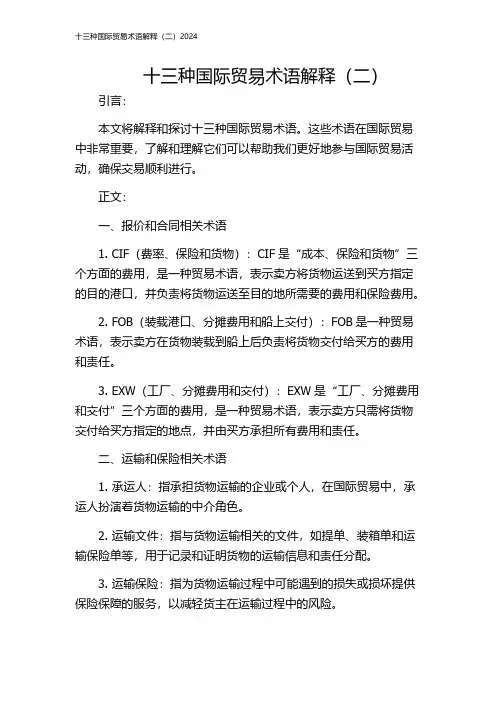
十三种国际贸易术语解释(二)引言:本文将解释和探讨十三种国际贸易术语。
这些术语在国际贸易中非常重要,了解和理解它们可以帮助我们更好地参与国际贸易活动,确保交易顺利进行。
正文:一、报价和合同相关术语1. CIF(费率、保险和货物):CIF是“成本、保险和货物”三个方面的费用,是一种贸易术语,表示卖方将货物运送到买方指定的目的港口,并负责将货物运送至目的地所需要的费用和保险费用。
2. FOB(装载港口、分摊费用和船上交付):FOB是一种贸易术语,表示卖方在货物装载到船上后负责将货物交付给买方的费用和责任。
3. EXW(工厂、分摊费用和交付):EXW是“工厂、分摊费用和交付”三个方面的费用,是一种贸易术语,表示卖方只需将货物交付给买方指定的地点,并由买方承担所有费用和责任。
二、运输和保险相关术语1. 承运人:指承担货物运输的企业或个人,在国际贸易中,承运人扮演着货物运输的中介角色。
2. 运输文件:指与货物运输相关的文件,如提单、装箱单和运输保险单等,用于记录和证明货物的运输信息和责任分配。
3. 运输保险:指为货物运输过程中可能遇到的损失或损坏提供保险保障的服务,以减轻货主在运输过程中的风险。
三、支付和结算相关术语1. 电汇(T/T):电汇是一种国际贸易中常用的支付方式,通过银行转账将买方支付给卖方的款项直接转到卖方的账户。
2. 信用证(L/C):信用证是一种由买方的银行开出的支付保证,表示买方已经向银行预付款项,以确保卖方在交货后可以获得付款。
3. 托收(D/P):托收是指卖方将货物的运输文件委托给银行,由银行代为向买方收款。
卖方在买方支付后才能获得货款。
四、关税和贸易条款相关术语1. 最惠国待遇:最惠国待遇是指一个国家给予另一个国家的贸易优惠待遇,即把某种待遇扩大到其他国家,以促进国际贸易的发展。
2. 关税配额:关税配额是指对进口商品征收的特定税额上限,超过配额的商品需要缴纳更高的关税。
3. 非关税贸易壁垒:非关税贸易壁垒是指除了关税之外的其他措施,如进口限制、出口限制、补贴和反倾销措施等,用于保护本国产业。
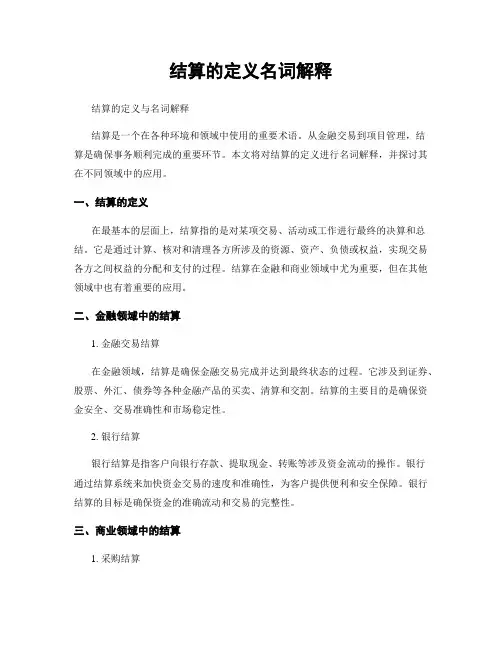
结算的定义名词解释结算的定义与名词解释结算是一个在各种环境和领域中使用的重要术语。
从金融交易到项目管理,结算是确保事务顺利完成的重要环节。
本文将对结算的定义进行名词解释,并探讨其在不同领域中的应用。
一、结算的定义在最基本的层面上,结算指的是对某项交易、活动或工作进行最终的决算和总结。
它是通过计算、核对和清理各方所涉及的资源、资产、负债或权益,实现交易各方之间权益的分配和支付的过程。
结算在金融和商业领域中尤为重要,但在其他领域中也有着重要的应用。
二、金融领域中的结算1. 金融交易结算在金融领域,结算是确保金融交易完成并达到最终状态的过程。
它涉及到证券、股票、外汇、债券等各种金融产品的买卖、清算和交割。
结算的主要目的是确保资金安全、交易准确性和市场稳定性。
2. 银行结算银行结算是指客户向银行存款、提取现金、转账等涉及资金流动的操作。
银行通过结算系统来加快资金交易的速度和准确性,为客户提供便利和安全保障。
银行结算的目标是确保资金的准确流动和交易的完整性。
三、商业领域中的结算1. 采购结算采购结算是指企业与供应商之间的货款和杂费支付的过程。
它包括核对数量、单价和价格的准确性,与供应商进行协商,并最终将款项支付给供应商。
采购结算对于维护供应链的稳定和供应商关系的良好发展至关重要。
2. 销售结算销售结算是指企业与客户之间的货款支付和结算的过程。
当销售交易发生后,企业需要确保客户按时支付货款,并进行核对和记录。
销售结算不仅有助于企业获取资金流入,还能帮助企业进行财务管理和预测。
四、项目管理中的结算在项目管理中,结算是指对项目进行总结和收尾的过程。
在项目完成后,结算包括对项目目标的完成程度进行评估,核对项目成本和资源的使用情况,并做出总结和报告。
项目结算有助于项目团队总结经验教训,推动持续改进和知识分享。
五、其他领域中的结算除了金融、商业和项目管理领域,结算也在其他领域中扮演着重要角色。
1. 电力结算在电力行业,结算是指对发电厂和电力用户之间用电情况进行核算和支付的过程。

结算和清算的名词解释在商业和金融领域中,结算和清算是两个经常出现的术语,它们在不同的情景下有不同的含义和用法。
本文将从几个角度来探讨结算和清算的定义和作用。
一、结算的定义和作用结算是指在交易完成后,双方通过支付货款和交付货物或服务来结束交易的过程。
这是一个财务行为,旨在确保交易双方的权益得到保障,同时减少交易风险。
结算可以发生在各种交易中,包括商品交易、股票交易、外汇交易等。
在商品交易中,结算通常涉及支付货款和交付商品的过程。
当买方通过银行转账或现金支付货款后,卖方就会交付商品,完成交易。
这个过程通常需要一段时间来核实交易款项和商品的真实性,以确保交易的安全和合法性。
结算的目的是保障双方的权益,确保交易的顺利进行。
在股票交易中,结算可以涉及支付证券的价格和交付股票的过程。
根据不同交易市场和司法管辖区的规定,股票交易的结算有不同的形式和流程。
通常,买方会通过经纪人或交易所支付股票价格,然后交易所或相关机构会执行交易并在特定的结算日转移股票的所有权。
这个过程需要进行确认和验证,以确保交易的可靠性和安全性。
在外汇交易中,结算涉及支付货币对的价格差异和交付货币的过程。
外汇交易通常是以不同货币之间的汇率进行的,交易双方在结算时必须根据市场汇率支付或接收相应的货币金额。
这个过程通常需要经过一些中介机构,以确保结算的准确性和及时性。
结算的作用不仅仅是为了完成交易,还有助于管理风险和建立信任。
通过结算,交易双方可以确保交易的合法性和安全性,减少欺诈和不当行为的风险。
结算也有助于建立信任,促进交易双方的合作和长期关系的发展。
二、清算的定义和作用清算是指将交易的资金和资产分配给应享有权益的各方的过程。
它是在交易结算后进行的,主要涉及计算和结算各方之间的权益和义务,并进行相应的转移和支付。
清算的目的是确保交易的公平和公正,保护各方的权益。
在金融领域,清算通常涉及金融机构作为中介来执行清算职责。
根据不同的金融市场和监管机构的规定,清算机构可能是交易所、结算银行或其他专门的机构。
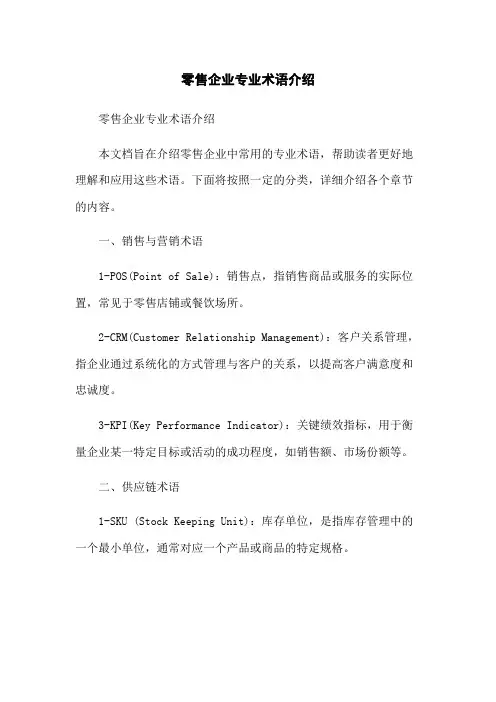
零售企业专业术语介绍零售企业专业术语介绍本文档旨在介绍零售企业中常用的专业术语,帮助读者更好地理解和应用这些术语。
下面将按照一定的分类,详细介绍各个章节的内容。
一、销售与营销术语1-POS(Point of Sale):销售点,指销售商品或服务的实际位置,常见于零售店铺或餐饮场所。
2-CRM(Customer Relationship Management):客户关系管理,指企业通过系统化的方式管理与客户的关系,以提高客户满意度和忠诚度。
3-KPI(Key Performance Indicator):关键绩效指标,用于衡量企业某一特定目标或活动的成功程度,如销售额、市场份额等。
二、供应链术语1-SKU (Stock Keeping Unit):库存单位,是指库存管理中的一个最小单位,通常对应一个产品或商品的特定规格。
2-RFID (Radio-Frequency Identification):射频识别技术,用于物流跟踪和库存管理,基于无线电信号实现对物品的识别和追踪。
3-JIT (Just-in-Time):准时生产/供应,是一种供应链管理方式,通过准确预测销售需求,实现原材料和产品的准时供应。
三、库存管理术语1-FIFO (First-In, First-Out):先进先出,是一种库存管理原则,指先进入库存的产品先出售,以保持库存的新鲜度,尤其适用于易腐商品。
2-Safety Stock:安全库存,是指为应对突发需求或供应链异常情况而保留的库存量,以避免缺货风险。
3-ABC Analysis:ABC分析,是货物按照重要性进行分类和排序的方法,A类为最重要的货物,C类为最不重要的货物,有助于优化库存管理和采购决策。
四、支付与结算术语1-POS Terminal (Point of Sale Terminal):销售终端,指与消费者进行支付交易的终端设备,如收银机、POS机等。
2-EFT (Electronic Funds Transfer):电子资金转账,指通过电子方式进行的资金转移,如银行卡、等在线支付方式。
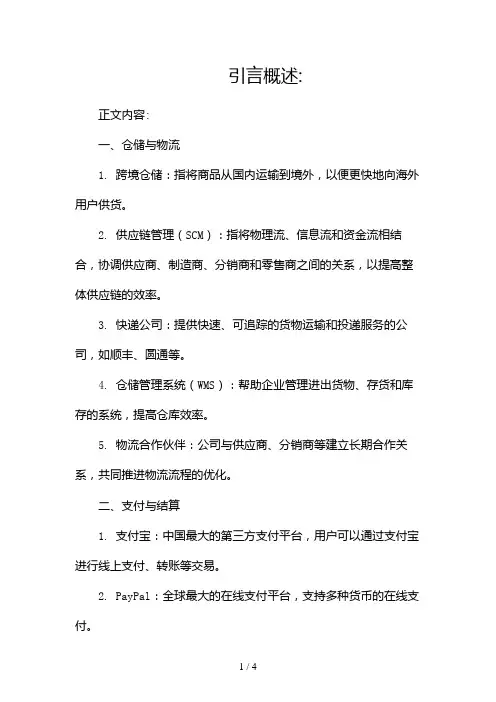
引言概述:正文内容:一、仓储与物流1. 跨境仓储:指将商品从国内运输到境外,以便更快地向海外用户供货。
2. 供应链管理(SCM):指将物理流、信息流和资金流相结合,协调供应商、制造商、分销商和零售商之间的关系,以提高整体供应链的效率。
3. 快递公司:提供快速、可追踪的货物运输和投递服务的公司,如顺丰、圆通等。
4. 仓储管理系统(WMS):帮助企业管理进出货物、存货和库存的系统,提高仓库效率。
5. 物流合作伙伴:公司与供应商、分销商等建立长期合作关系,共同推进物流流程的优化。
二、支付与结算1. 支付宝:中国最大的第三方支付平台,用户可以通过支付宝进行线上支付、转账等交易。
2. PayPal:全球最大的在线支付平台,支持多种货币的在线支付。
3. 银行卡支付:用户通过刷卡、转账等方式进行支付,以实现电商交易资金结算。
4. 现金支付:指在线下实际交易时,使用现金支付商品的交易方式。
5. POS机:点对点终端,用于刷卡消费和扣款,支付交易的便利工具。
三、用户体验与运营1. 用户画像(User Persona):根据用户数据和调研结果,划分不同用户群体的特征和需求。
2. 用户界面(User Interface,UI):指用户与系统交互的界面设计,包括界面元素、颜色搭配等。
3. 响应式网站(Responsive Website):根据用户使用设备的不同,自动调整页面布局和内容以获得更好的用户体验。
4. 数据分析(Data Analytics):利用数据挖掘、统计分析等方法对用户行为和交易数据进行分析,以优化运营策略。
5. 用户留存率(User Retention Rate):衡量用户在一定时间内继续使用产品或服务的比例,是评估用户粘性的指标之一。
四、市场推广与营销1. 搜索引擎优化(Search Engine Optimization,SEO):通过优化网站结构和内容,提高网站在搜索引擎中的排名,增加有机流量。
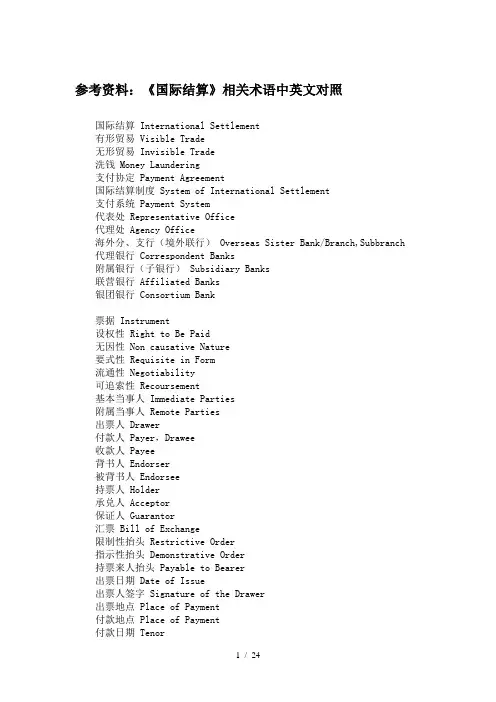
参考资料:《国际结算》相关术语中英文对照国际结算 International Settlement有形贸易 Visible Trade无形贸易 Invisible Trade洗钱 Money Laundering支付协定 Payment Agreement国际结算制度 System of International Settlement支付系统 Payment System代表处 Representative Office代理处 Agency Office海外分、支行(境外联行) Overseas Sister Bank/Branch,Subbranch 代理银行 Correspondent Banks附属银行(子银行) Subsidiary Banks联营银行 Affiliated Banks银团银行 Consortium Bank票据 Instrument设权性 Right to Be Paid无因性 Non causative Nature要式性 Requisite in Form流通性 Negotiability可追索性 Recoursement基本当事人 Immediate Parties附属当事人 Remote Parties出票人 Drawer付款人 Payer,Drawee收款人 Payee背书人 Endorser被背书人 Endorsee持票人 Holder承兑人 Acceptor保证人 Guarantor汇票 Bill of Exchange限制性抬头 Restrictive Order指示性抬头 Demonstrative Order持票来人抬头 Payable to Bearer出票日期 Date of Issue出票人签字 Signature of the Drawer出票地点 Place of Payment付款地点 Place of Payment付款日期 Tenor见票即付 At Sight or on Demand定日付款 At a Fixed Date见票后定期付款 At a Fixed Period after Sight出票后定期付款 At a Fixed Period after Date付一不付二 Pay This First/Second Bill担当付款人 Person Designated as payer预备付款人 Referee in Case of Need必须提示承兑 Presentment for Acceptance Required 不得提示承兑 Acceptance Prohibited付对价持票人 Holder for Value正当持票人Holder in Due Course/Bona Fide Holder 银行汇票 Banker’s Draft商业汇票 Trade Bill承兑汇票Acceptance Bill银行承兑汇票 Banker’s Acceptance Bill商业承兑汇票 Trade’s Acceptance Bill即期汇票 Sight Draft ,Demand Draft远期汇票 Time Bill, Usance Bill光票 Clean Bill跟单汇票 Documentary Bill本票 Promissory Note商业本票Promissory Note银行本票 Cashier’s Order/Check国际汇票 Overseas Money Order支票 Cheque or Check出票 Issue背书 Indorsement承兑 Acceptance保证 Guarantee保付 Certified to Pay提示 Presentation付款 Payment拒付 Dishonour追索 Recourse顺汇 Remittance逆汇 Reverse Remittance汇款人 Remitter汇出行 Remitting Bank汇入行 Paying Bank收款人 Payee电汇 Telegraphic Transfer信汇 Mail Transfer票汇 Remittance by Banker’s Demand Draft预付货款 Payment in Advance货到付款 Payment after Arrival of the Goods托收 Collection委托人 Principal托收行 Remitting Bank代收行 Collecting Bank付款人 Drawee提示行 Presenting Bank托收申请书 Collection Application托收委托书 Collection Advice信用证 Letter of Credit议付行 Negotiating Bank偿付行 Reimbursing Bank开证申请人Applicant开证行 Issuing Bank受益人 Beneficiary通知行 Advising Bank保兑行 Confirming Bank付款行 Paying Bank光票信用证 Clean Credit跟单信用证 Document Credit不可撤销信用证Irrevocable Credit可撤销信用证 Revocable Credit保兑信用证 Confirmed Credit不保兑信用证 Unconfirmed Credit即期付款信用证 Sight Payment Credit延期付款信用证 Deferred Payment Credit承兑信用证 Acceptance Credit转让信用证 Transferable Credit不可转让信用证 Nor-transferable Credit背对背信用证 Back to Back Credit循环信用证 Revolving Credit预支信用证 Anticipatory Credit银行保函 Letter of Guarantee申请人 Applicant/Principal受益人 Beneficiary担保行 Guarantor Bank通知行 Advising Bank转开行 Reissuing Bank反担保行 Counter Guarantor Bank保兑行 Confirming Bank投标保函 Tender Gurantee履约保函 Performance Gurantee预付款保函 Advanced Payment Gurantee质量保函Quality Gurantee关税保付保函 Customs Gurantee付款保函 Payment Gurantee延期付款保行 Defeerd Payment Gurantee补偿贸易保函 Compensation Gurantee来料加工保函 Processing Gurantee租赁保函 Lease Gurantee借款保函 Loan Gurantee保释金保函 Bail Bond票据保付保函Gurantee For Bill费用保付保函 Payment Gurantee for Commission 备用信用证 Stand-by Letter of Credit单据 Documents商业发票 Commercail Invoice首文 Heading正文Body海关发票 Customs Invoice形式发票 Proforma Invoice领事发票 Consular Invoice样品发票 Sample Invoice广商发票 Manufacturer Invoice证实发票 Certified Invoice货物运输单据 Transport documents海运提单Marine Bill of Loading托运人 Shipper/Consignor承运人 Carrier收货人 Consignee受让人 Transferee or Assignee已装船提单 Shipped on Board待运提单 Received for Shipment直达提单Direct B/L转船提单 Transshipmen B/L联运提单 Through B/L清洁提单 Clean B/L不清洁提单 Unclean B/L记名提单 Straight B/L不记名提单 Open B/L指示性提单 Order B/L简式提单 Short Form B/L全式提单 Long Form B/L班轮提单 Liner B/L租船提单 Charter B/L运输代理行提单 Horse B/L过期提单 Stale B/L倒签提单Anti-dated B/L集装箱运输提单 Container B/L多式运输 Multimodal Transport多是运输单据Multimodal Transport Document不可流通转让的海运单 Non-negotiable Sea Waybill租船合约提单 Charter Party Bill of Lading航空运单 Airway Bill基本险 Chief Risk一般附加险 Additional Risk特殊附加险 Special Additional Risk保险单 Insurance Policy预约保险单Open Policy of Open Cover保险凭证 Insurance Certificate保险声明 Insurance Declaration联合凭证 Combined Certificate暂保单 Cover Note商品验证说明 Inspection Certificate产地证明书 Certificate of Origin包装单据 Packing Document装货箱 Packing List重量单 Weight List打包贷款 Packing Credit/Loan出口押汇 Outward Bill质押书 Letter of Hypothecation出口托收押汇 Advance against Documentary Collection 银行承兑 Bank’s Acceptance票据贴现 Bill Discount出口发票 Invoice Discounting进口开证额度 Limits for Issuing of Credit信托收据 Trust Receipt, T.R, T/R留置权书 Letter of Lien进口押汇 Inward Bills进口信用证押汇 Inward Bill Receivables买房远期信用证 Buyer’s Usance L/C提货担保 Delivery against Bank Guarantee国际保理 International Factoring销售分户账管理 Maintenance of The Sales Ledger债款回收 Collection from Debtors信用销售控制 Credit Control坏账担保 Full Protection Against Bad Debts贸易融资 Trade Financing福费廷 Forfaiting贴现率 Discount Rate承诺费 Commitment Fee利息补贴 Interest Make-up侨汇 Overseas Chinese Remittance外币兑换业务 Exchange of Foreign Currency旅行支票 Traveler’s Cheque信用卡 Credit Card万事达卡 Master Card维萨卡 VISA Card运通卡 American Express Card大莱卡 Diners Club Car国际贸易结算:以票据为基础,单据为条件,银行为中枢,结算与融资相结合的非现金结算体系。
rfs的银行术语RFS(Real-time Financial Services)是一种通过实时传输数据和提供金融服务的技术平台。
在这个数字化时代,金融机构不仅需要掌握金融业务的核心知识,还需要熟悉大量的银行术语。
本文将介绍一些与RFS相关的银行术语,帮助读者更好地理解和应用这些术语。
一、支付结算类银行术语1. 支付网关(Payment Gateway)支付网关是指金融机构提供的用于在线支付的技术系统。
它连接商户和银行之间的交易流程,确保支付过程的安全性和稳定性。
支付网关通常涉及数据加密、风险控制和支付通道等功能。
2. 双因素认证(Two-factor Authentication)在进行网上支付时,银行要求用户同时提供两种独立的身份认证信息,以确保支付的安全性。
这些身份认证信息可能包括密码、指纹、短信验证码等,通过双重验证的方式,提高了支付过程的安全性。
3. 清算(Clearing)清算是指在交易完成之后,将资金从买方的账户转移到卖方的账户的过程。
清算过程需要经过银行的结算系统来完成,确保交易双方资金的及时转移和结算。
4. 结算(Settlement)结算是指清算之后的资金处理过程,将资金从银行的虚拟账户转移到实际的银行账户中。
结算一般需要较长的时间周期,包括银行内部的审核和系统处理。
5. 无卡支付(Cardless Payment)无卡支付是指在不使用实体信用卡或借记卡的情况下,通过其他方式完成支付。
例如,使用手机支付、支付宝、微信支付等。
无卡支付在方便用户的同时,也提高了支付安全性。
二、风险管理类银行术语1. 风险评估(Risk Assessment)风险评估是金融机构对客户资信、行为和风险水平进行评估的过程。
通过对各种因素的综合考量,金融机构可以评估客户的可信度,并基于评估结果决定是否提供借贷、信用卡等服务。
2. 信用评分(Credit Scoring)信用评分是金融机构用来衡量个人或机构信用风险的一种方法。
支付行业最全术语一.什么是限额?POS机限额常见与对私账户结算的商户,如单笔交易限额,或单卡交易限额,或每日到账限额等根据收单方不同的风险控制政策做出不同的限额要求以降低非法交易的风险。
二.什么是跳码?所谓的跳码一般情况是指商户明明申请的是标准类行业费率,但实际消费对账单却是优惠类或减免类等费率更低的行业,收单方以获取更高的手续费差价利润。
有商户经常疑惑,为何以前消费有积分现在没有积分了或者有时候有积分有时候没有,这是由于收单方利用系统判别交易额度,将有利润的交易转送费率更低的通道导致的。
三.什么叫做本地商户落地?所谓的落地商户,是指一些个人申请的POS机或刷卡器用来刷自己的信用卡,如果发卡行在后台看到该卡总是在同一家商户消费会被认为有套现或风险交易嫌疑,为了规避这种情况,收单方在系统设置,每消费一笔交易可以自动跳转显示不同的商户名头,并且商户的地址为本地。
如果不落地,随便全国跳转商户的话,在短时间内异地消费,很明显是异常消费,会影响信用卡的使用。
四.商户的名称可以随便取吗?不可以随意起,按照银联规定的交易报文关于(商户名称中文填写指南)要求,商户名称由行政区划、字号、行业、组织形式依次组成。
五.什么叫一机一码?正规办理出来的机器即为一机一码,根据商户的五证信息,由银联授权并可查的商户MCC码绑定在一台机器上以保障商户的资金安全。
六.为什么POS机没有查询余额功能有的收单方为了防止恶意测试银行卡密码行为,所以关闭银行卡余额查询功能。
七.什么是切机?将POS机原有的银行卡收单提供方更换为新的银行卡收单提供方。
八.什么携机入网?POS机终端的来源一般有两个地方,要么是由支付公司提供的定制机,已经在POS 机内安装好了属于该品牌的POS机程序,要么是由POS终端厂家售卖的裸机,由下游渠道商议价购买,并自行安装支付公司提供的属于该款机型的POS机程序,并且需要需要将这些自行携带的裸机的设备号录入支付公司的系统数据库。
支付结算相关名称解释一、支付结算的概念支付结算是指在经济交易中,债权人和债务人之间进行货币资金的转移,以达到债务的清偿和债权的实现的过程。
在商业活动中,支付结算是必不可少的环节,它涉及到各种支付方式、金融机构、交易方等各种概念。
本文将对支付结算相关的名称进行解释,让读者对这些概念有更加准确的认知。
二、名称解释1. 银行银行是指经过政府批准并注册成立的专营吸收公众存款并放贷的金融机构。
银行在支付结算中扮演着重要的角色,它提供各种支付工具,如支票、贷记卡、借记卡等,用于完成交易中的资金的转移。
2. 账户账户是银行为客户提供的一种记录存取资金的工具。
在支付结算中,债权人和债务人需要通过各自的账户进行资金的转移。
常见的账户包括储蓄账户、借记卡账户、信用卡账户等。
3. 支付工具支付工具是指在经济交易中用于支付的一种工具。
常见的支付工具包括现金、支票、银行卡、电子支付等。
不同的支付工具有不同的特点和使用方式,可以根据实际需求选择适合的支付工具。
4. 支票支票是一种由银行为客户提供的付款凭证。
持有支票的债权人可以通过银行兑现支票来获得相应金额的资金。
支票在支付结算中被广泛使用,尤其在大额交易和跨行交易中,具有安全、方便的特点。
5. 转账转账是指将资金从一个账户转移到其他账户的行为。
转账可以是银行间的转账,也可以是个体之间的转账。
在支付结算中,债权人可以通过转账的方式将资金划入债务人的账户,实现债务的清偿。
6. POS机POS机是一种用于完成支付交易的终端设备。
POS机通过与银行系统连接,可以读取信用卡、借记卡等支付工具上的信息,将交易金额从消费者的账户划入商家的账户,完成支付交易。
POS机广泛应用于各种零售业态中,如超市、商场、餐饮等。
7. 网络支付网络支付是指借助互联网技术实现的支付方式。
通过在电子商务平台输入支付工具信息,债权人可以完成向债务人的支付行为。
网络支付具有快捷、便利、安全的特点,目前已成为支付结算中最主要的方式之一。
支付系统设计申请申请关键术语支付系统:支付系统(Payment System)是由提供支付清算服务的中介机构和实现支付指令传送及资金清算的专业技术手段共同组成,用以实现债权债务清偿及资金转移的一种金融安排,有时也成为清算系统(Clear System)。
支付系统构成:(1)银行;(2)清算机构(清算所);(3)支付系统的管理者(中央银行);(4)国家法律与支付系统的运作规章;(5)支付工具。
全额:全额结算是指在资金转账前并不进行账户金额的对冲,而以实际的支付金额进行转账的结算方式。
全额结算支付系统对各金融机构的每笔转账业务进行一一对应结算,而不是在指定时点进行总的借、贷方净额结算。
净额结算指证券登记结算机构以结算参与人为单位,对其买入和卖出交易的余额进行轧差,以轧差得到的净额组织结算参与人进行交收的制度大额:“大额”是指规定金额起点以上的业务。
小额:小额支付系统,是中国人民银行现代化支付系统的重要组成部分,主要处理跨行同城、异城纸质凭证截留的借记支付业务以及金额在规定起点以下的小额贷记支付业务(目前人行暂定为2万元〈含〉限额以下),实现不同地区、不同银行营业网点的资源共享实时:在某事发生、发展过程中的同一时间进行其他动作;如,实时结算的支付系统就是在支付的同一时间进行结算的系统。
非实时:是指在支付系统中,从系统收到指令到完成结算之间有一定的时间间隔,此间隔随支付系统的不同而不同。
清分:清分是支付结算系统的最主要组成部分之一,指对进入系统的支付指令进行归类、排序、分析或计算,是随机传入支付系统的支付指令被整齐的分类,以便于系统进一步处理。
支付系统对支付指令的清分是根据支付系统的设计要求,根据支付指令的不同属性,对支付指令进行不同的处理。
包括清分的对象和清分的流程两个方面。
同时,清分的过程中,资金并没有进行实际的转移。
清分的对象是一系列的实体,即各类经济主体发出的各类支付指令。
结算:结算过程根据清分的结果进行资金在有关账户之间的实际意义上的转移1.简述支付体系构成和其中各个组成部分的作用?一个有效且高效的支付体系包括稳定的支付机构(如银行和清算机构),有效且便利的支付工具,高效稳定的清分结算系统,同时还要有一道运作规章和法律法规作为保证。
支付结算系统术语与解释支付结算系统术语与解释Aassured payment system: an arrangement in an exchange-for-value system under which completion of timely settlement of a payment instruction is supported by an irrevocable and unconditional commitment from a third party (typically a bank, syndicate of banks or clearing house).受保支付系统:一种价值交换系统协议,其中,一笔支付指令的按时结算完成需要第三方(通常为银行、银行辛迪加、清算所)不可撤销与无条件的承诺支持。
automated clearing house: an electronic clearing system in which payment orders are exchanged among financial institutions, primarily via magnetic media or telecommunications networks, and handled by a data processing centre.自动化清算所(ACH):一种电子清算系统,系统中支付指令主要通过磁介质或电信网络在金融机构之间进行交换并由数据处理中心处理。
automated teller machine: an electromechanical device that permits authorised users, typically using machine-readable plastic cards, to withdraw cash from their accounts and/or access other services, such as balance enquiries, transfer of funds or acceptance of deposits. ATMs may be operated either online with real-time access to an authorization database or offline.自动柜员机(ATM):一种机电设备,授权用户通常可利用机器可读的塑料卡,从其帐户提取现金并可访问其他如余额查询、资金转帐、接收存款等服务。
支付结算系统术语与解释/thread-118966-1-1.htmlAassured payment system: an arrangement in an exchange-for-value system under which completion of timely settlement of a payment instruction is supported by an irrevocable and unconditional commitment from a third party (typically a bank, syndicate of banks or clearing house).受保支付系统:一种价值交换系统协议,其中,一笔支付指令的按时结算完成需要第三方(通常为银行、银行辛迪加、清算所)不可撤销与无条件的承诺支持。
Automated Clearing House: an electronic clearing system in which payment orders are exchanged among financial institutions, primarily via magnetic media or telecommunications networks, and handled by a data processingcentre.自动化清算所(ACH):一种电子清算系统,系统中支付指令主要通过磁介质或电信网络在金融机构之间进行交换并由数据处理中心处理。
Automated Teller Machine: an electromechanical device that permits authorised users, typically using machine-readable plastic cards, to withdraw cash from their accounts and/or access other services, such as balance enquiries, transfer of funds or acceptance of deposits. ATMs may be operated either online with real-time access to an authorizationdatabase or offline.自动柜员机(ATM):一种机电设备,授权用户通常可利用机器可读的塑料卡,从其帐户提取现金并可访问其他如余额查询、资金转帐、接收存款等服务。
ATM 可以以联机实时访问授权数据库或脱机两种方式运行。
Bbank draft: in Europe, the term generally refers to a draft drawn by a bank on itself. The draft is purchased by the payer and sent to the payee, who presents it to his bank for payment. That bank presents it to the payer’s bank for reimbursement. In the United States, the term generally refers to a draft or cheque drawn by a bank on itself or on funds depositedwith another bank. In the case of a cashier’s c heque, the bank is both the drawer and drawee. In the case of a teller’s cheque, one bank is the drawer and a second bank is the drawee. Bank drafts may be written by a bank for its own purposes or may be purchased by a customer and sent toa payee to discharge an obligation.银行汇票:在欧洲,该术语通常指一种由银行自身兑付的票据。
银行汇票由付方在银行购买并发送给收方,收方向其开户银行提交银行汇票要求支付,收方开户银行再将银行汇票提交给付方银行要求偿付。
在美国,该术语通常指由银行自身或者从其他银行兑付的汇票或支票。
在银行本票中,银行既是出票人又是受票人。
在银行柜员支票中,一家银行是出票人,另一家银行是受票人。
银行汇票可能由银行根据自身目的签发或由客户购买并发送给收款人以清偿债务。
Batch: the transmission or processing of a group of payment orders and/or securities transfer instructions as a set at discrete intervals of time.批处理:一组支付指令和/或证券转让指令作为一个集合以不连续的时间间隔发送或处理。
bilateral net settlement system: a settlement system in which participants’ bilateral net settl ement positions are settled between every bilateral combination of participants.双边轧差结算系统:一种结算系统,其中参与者的双边轧差结算余额在每对参与者之间进行结算。
bilateral netting: an arrangement between two parties to net their bilateral obligations. The obligations covered by the arrangement may arise from financial contracts, transfers or both. See also multilateralnetting, netting, net settlement.双边轧差:双方之间对其双边债务进行轧差的协议。
协议包含的债务可能产生于金融合同或转帐交易,或同时产生于两者。
bill of exchange: a written order from one party(the drawer)to another (the drawee)to pay a specified sum on demand or on a specified date to the drawer or to a third party specified by the drawer. Widely used to finance trade and, when discounted with a financial institution, to obtaincredit.汇票:一方(出票人)提交给另一方(受票人)的书面票据,要求受票人向出票人或出票人指定的第三方随时或在规定的日期支付一笔特定的数额。
广泛用于金融交易以及(当在银行贴现时)获得信用。
book-entry system: an accounting system that permits the transfer of claims(eg electronic transfer of securities)without the physical movement of paper documents or certificates.簿记系统:一种记帐系统,在没有票据或凭证实物移动的情况下能够进行债权转让,如证券电子化转让。
Ccash card: card for use only in ATMs or cash dispensers(other cards often have a cash function that permits the holder to withdraw cash).提款卡:只在ATM或自动提款机上使用的卡,通常其他卡也有提款功能,允许持卡人提取现金。
cash dispenser: electromechanical device that permits consumers, typically using machine-readable plastic cards, to withdraw banknotes (currency) and, in some cases, coins. See also automated teller machine.自动提款机:一种机电设备,允许消费者主要利用机器可读的塑料卡提取纸币现金,有时也可提取硬币。
central securities depository: a facility (or an institution) for holding securities, which enables securities transactions to be processed by book entry. Physical securities may be immobilised by the depository or securities may be dematerialised (ie so that they exist only as electronic records). In addition to safekeeping, a central securities depository may incorporate comparison, clearing and settlement functions.中央证券托管:一种保管证券的服务或机构,它使证券交易可由簿记系统进行处理。
实物证券可以固定地由托管机构保管(而不进行实物交割),或实现证券的无形化(即证券可仅以电子记录的形式存在)。
除了保管以外,中央证券托管还可能结合撮合、清算与结算功能。
cheque: a written order from one party(the drawer)to another(the drawee, normally a bank)requiring the drawee to pay a specified sum on demand to the drawer or to a third party specified by the drawer. Cheques may be used for settling debts and withdrawing money from banks.支票:一方(出票人)提交给另一方(受票人,通常是银行)的书面票据,要求受票人对出票人或出票人指定的第三方随时支付一笔特定的数额。